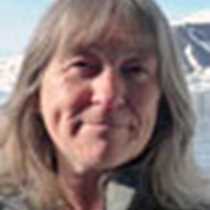The Outer Isles, Scotland
Through the night the Endeavour had brought us from the sheltered waters of the Inner Hebrides westwards to the most isolated outpost of the British Isles. We awoke to see the famous outlying stacks of St Kilda coming into view: Stac an Armin, Stac Lee and Boreray, rising sheer out of the Atlantic waters, remnants of a 60 million year old volcano complex. Upon these stacks is situated our most important gannetry, with 60,000 breeding pairs, along with Britain’s largest fulmar colony, a spectacular sight as we cruised among them towards our morning’s destination, St Kilda’s main island of Hirta.
St Kilda is a World Heritage Site owned and managed by the National Trust for Scotland. The Trust’s warden, Andy Robinson, and the resident archaeologist, Sue Bain, showed us around the Village Bay settlement, laid out in a crescent around the bay in 1830. The people of St Kilda survived an incredibly hard life of near total isolation, harvesting the seabirds and their eggs, supplemented with oats, potatoes and a little produce from their cows and sheep. Their stone cottages, left unoccupied since the St Kilda community finally decided to abandon its precarious living on the island in 1930, remain as a silent witness to the lives of these remarkable islanders (see photo). Now the island is a haven for wildlife and birds. Soay sheep, the original form of prehistoric domesticated sheep, wander freely on St Kilda. Walkers who hiked up to high ground behind the village, past the many drystone cleats which served as airy storage sheds, came across nesting skuas and fulmars, and heard the song of the tiny St Kilda wren.
After a delightful Filipino buffet dinner, we were ready once again to go ashore, this time to explore the standing stones of Calanais (Callanish) on the Isle of Lewis. A Zodiac ride into Loch Roag in lengthening sunshine put us within a short stroll of this amazing prehistoric complex. An early farming community erected these stones around 5,000 years ago on a prominent ridge, of exquisitely beautiful blocks of Lewisian Gneiss hewn from nearby quarry faces. From this site the movement of heavenly bodies, in particular the moon with which these people seemed to have a particular affinity, could be observed along the horizon. A group of hills, known in Gaelic as ‘Cailleach na Mointeach’ (Old Woman of the Moors), significantly forms the shape of a recumbent female figure as seen from the stone circle. This monument, so little known to modern day travelers, was known to the ancient Greeks, who describe ‘a magnificent sacred precinct, a notable temple spherical in shape,’ ‘where the moon as viewed from this island appears to be but a little distance from the earth.’ Greylag geese passed overhead as the sun sank low in the west, covering the stones and the hills beyond in a glow of light. It was an irresistible moment.
Through the night the Endeavour had brought us from the sheltered waters of the Inner Hebrides westwards to the most isolated outpost of the British Isles. We awoke to see the famous outlying stacks of St Kilda coming into view: Stac an Armin, Stac Lee and Boreray, rising sheer out of the Atlantic waters, remnants of a 60 million year old volcano complex. Upon these stacks is situated our most important gannetry, with 60,000 breeding pairs, along with Britain’s largest fulmar colony, a spectacular sight as we cruised among them towards our morning’s destination, St Kilda’s main island of Hirta.
St Kilda is a World Heritage Site owned and managed by the National Trust for Scotland. The Trust’s warden, Andy Robinson, and the resident archaeologist, Sue Bain, showed us around the Village Bay settlement, laid out in a crescent around the bay in 1830. The people of St Kilda survived an incredibly hard life of near total isolation, harvesting the seabirds and their eggs, supplemented with oats, potatoes and a little produce from their cows and sheep. Their stone cottages, left unoccupied since the St Kilda community finally decided to abandon its precarious living on the island in 1930, remain as a silent witness to the lives of these remarkable islanders (see photo). Now the island is a haven for wildlife and birds. Soay sheep, the original form of prehistoric domesticated sheep, wander freely on St Kilda. Walkers who hiked up to high ground behind the village, past the many drystone cleats which served as airy storage sheds, came across nesting skuas and fulmars, and heard the song of the tiny St Kilda wren.
After a delightful Filipino buffet dinner, we were ready once again to go ashore, this time to explore the standing stones of Calanais (Callanish) on the Isle of Lewis. A Zodiac ride into Loch Roag in lengthening sunshine put us within a short stroll of this amazing prehistoric complex. An early farming community erected these stones around 5,000 years ago on a prominent ridge, of exquisitely beautiful blocks of Lewisian Gneiss hewn from nearby quarry faces. From this site the movement of heavenly bodies, in particular the moon with which these people seemed to have a particular affinity, could be observed along the horizon. A group of hills, known in Gaelic as ‘Cailleach na Mointeach’ (Old Woman of the Moors), significantly forms the shape of a recumbent female figure as seen from the stone circle. This monument, so little known to modern day travelers, was known to the ancient Greeks, who describe ‘a magnificent sacred precinct, a notable temple spherical in shape,’ ‘where the moon as viewed from this island appears to be but a little distance from the earth.’ Greylag geese passed overhead as the sun sank low in the west, covering the stones and the hills beyond in a glow of light. It was an irresistible moment.




